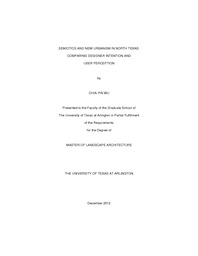| dc.description.abstract | Design is a means of communication and the conduit for transmitting a message between designers and users of their built work (Fiske, 1990). The design work resembles the cultivated construction and carrier of a message as a language. The designer encodes the message or information into design elements through his/her built work, and the user decodes it. Therefore, designers convey their intentions by incorporating them into the patterns of shape, structure, material, and landscape of the site (Krieger and Saunders, 2009). A design element has no intrinsic meaning. According to Manning (2004), a design element "is something that makes sense in the mind of some person, [and it] may be seen usefully as the connection between an expression and a content" (p.567). Accordingly, design work can have a penumbra of meanings, depending on who is interpreting them. No observers have exactly the same background and point of view. In order to understand how people construct a meaning from the interpretation of the built environment, this research examines the relationship between the designer's intentions and the user's perceptions. The theoretical background of this study is semiotics, an examination of how designers and users interpret design elements as non-verbal communication. Semiotics is a transparent and appropriate tool that offers a suitable framework for the study of meaning transference in places (Krampen et al., 1987; Rose, 2007; Gottdiener, 1995). Meaning is not something apart from function, but is itself a most important aspect of function. Additionally, semiotics offers a very full box of perspectives for taking a built environment apart and tracing how it works in relation to broader systems of meaning and how people explain design elements of new urbanism projects. This study explores the relationship between designer's intentions and users perceptions in new urbanism project. The purpose of this research is to demonstrate and explore how transference of meaning into the built landscape represent and organized those intentions through the perspective of Addison Circle and Austin Ranch in North Texas. This research uses the qualitative research method, supported primarily by face-to-face interviews with in-depth, open-ended questions. Data from the interview were transcribed and analyzed according to Taylor and Bogdan's grounded theory approach (1998). The results indicate that meaning is an active process. When people start generating meaning through the use of elements from the places, a signification system is an autonomous occurrence (Danesi, 2007, p.180). This process can have three levels of meaning, including denotative meaning, connotative meaning, and deeper connotative meaning. Denotative meaning refers to the common-sense or the obvious meaning. Connotative meaning is the extended meaning of the design elements. Deeper connotative meaning is a catalyst for appropriation by designers and users. Consequently, the incorporation of meaning in the design work can revive the users' senses and stir their subconscious to create an environment that will facilitate personal association for an individual and a community. | en_US |


